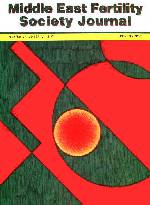
|
Middle East Fertility Society Journal
Middle East Fertility Society
ISSN: 1110-5690
Vol. 10, Num. 2, 2005, pp. 110-111
|
Middle East Fertility Society Journal, Vol. 10, No. 2, 2005, pp. 110-111
DEBATE
Prevention of multiple pregnancy in ART
|
Comment by:
|
Karl Nygren. M.D.
|
|
|
Stockholm, Sweden
|
Code Number: mf05019
Since several years back now, we have seen very convincing
evidence from many studies to show that triplets or more after ART carries with
them a very substantial increase of perinatal mortality and of short and long
term morbidity. In addition we also know that the psycho-social consequences
often are huge.
Twins
carry with them similar problems at a significant but somewhat lower scale. The
mothers suffer from a large increase of obstetrical complications.
At
the recent ESHRE Annual Meeting in Copenhagen, two additional strong reasons to avoid at
least high order of multiple pregnancy after ART were presented.
First,
the economy. Two reports, one from the Nordic countries and one from France clearly
demonstrated that the total cost, including cost for deliveries and post-natal
complications, were very much higher with a clinical policy leading to high
proportions of multiples. The myth, therefore, that multiples would help
reducing cost is totally false because it does not include cost for
complications.
Second,
national statistics showing the feasibility of a national policy of a high
proportion of elective single embryo transfers (e-SET). National data from
Finland and Sweden and also from Belgium now show, with treatments during 2004,
that a high proportion of e-SET (over 50%) is proven to be compatible with
a continuously
high pregnancy rate per embryo transfer in fresh cycles (over 30%) leading
to a
substantial decrease of multiple deliveries to now below 10% of twins and
virtually no triplets.
The
conclusion is, that high order of multiple pregnancy after ART, can no longer
be defended by economical evidence or evidence of low effectiveness.
A
shift over to a clinical policy to avoid high order of multiple deliveries and
to at least to decrease the proportion of twins is therefore only logical.
How
can that be achieved, in clinical practice? Several suggestions put forward may
be summarized as follows:
- Select, for e-SET, women under 38 years of age, during their first (and
possibly second) IVF cycle.
- Select, for e-SET, women with an obstetrical increased risk with multiple
gestation.
- Stimulate for 10-12 eggs, at aspiration.
- Transfer the best embryo and freeze the other suitable
embryos one by one. Transfer them one by one.
- Use high quality freezing equipment and monitor transfer cycles closely.
- To present success, use combined fresh and frozen delivery rates, i.e. delivery
rates by aspiration procedure.
- Transfer 2 embryos otherwise, but never three.
- Convince your staff and your patients that such a policy is founded on
very sound evidence, and is in the best interest of all parties involved,
and that
it is not counter productive for efficacy or cost.
Are
there any negative sides to such a policy?
1.
Q: Is it more cost-effective with multiples?
A:
No, it is not. It may appear so, in the ultra-short term, if only direct
treatment cost is included, but in a longer perspective that is not at all
true.
2.
Q: Do multiples save time for the couple to achieve their reproductive goal for
a larger family?
A:
Only marginally so. And it saves quality of life for children and families
alike.
So,
all evidence available on
a/
medical risks,
b/
psycho-social problems,
c/
economy and
d/
feasibility for effectiveness
all
speak the same language: A shift in clinical policy to avoid, totally, high
order of multiple pregnancy (triplets or more) and to decrease the proportion
of twins is logical, rational and beneficial to all parties involved.
REFERENCES
- Granberg
M, Nygren KG, Wikland M. Cost of IVF in the Nordic countries. Hum Reprod
Vol 20, Suppl 1 2005: Abstract book. ESHRE 21st Annual Meeting, Copenhagen
O-269,
i100.
-
J. de
Mouzon, J.L.Pouly, Mourouvin, A.Bachelot: Multiple pregnancies. How much
they cost for a nation? Hum Reprod Vol 20, Suppl 1 2005: Abstract book.
ESHRE 21st
Annual Meeting, Copenhagen 0-270, I 100.
-
K.Erb,
A Nyboe Andersen, J.M. Gissler, A. Tiitinen, J.Hazekamp, P.O. Karlstrom:
A shift towards single embryo transfer in ART. National data from the
Nordic
Countries 2002 and 2003. Hum Reprod Vol 20, Suppl 1 2005: Abstract book.
ESHRE 21st Annual Meeting, Copenhagen 0-152, i 56.
Karl Nygren, MD
IVF-clinic at Sophiahemmet Hospital,
Stockholm,
Sweden.
© Copyright 2005 - Middle East Fertility Society
|
